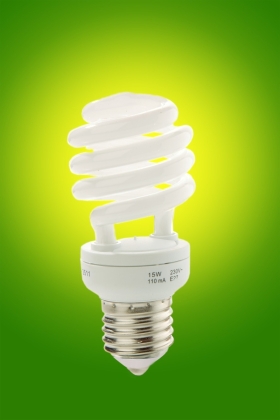Energy Saving Light Bulbs
The reason for getting us to switch to CFLs is simple. Germana Canzi, a campaigner for Friends of the Earth, explains: \"Electricity counts for roughly one-fifth of our energy use, and is respo...

The reason for getting us to switch to CFLs is simple. Germana Canzi, a campaigner for Friends of the Earth, explains: Electricity counts for roughly one-fifth of our energy use, and is responsible for approximately a third of our carbon emissions. More than 70% of this electricity is generated using fossil fuels, and in the conversion process, around 65% of that energy is wasted.
Reducing wastage
In short, she says: Well over half of the carbon emitted for generating electricity is not being used to produce anything.
One way to reduce this wastage, says Dhiru Galani, technical advisor at the lightbulb maker Osram, is to switch to CFLs: If each of the 20 million households in the UK were to install only one, enough energy would be saved to close a power station.
But to the customer, energy savings mean cash. Each standard bulb replaced with an energy saver can take up to £10 per year off an electricity bill, says James Russill, the evaluation and quality manager at the Energy Saving Trust. By replacing every light fitting in the home with a low-energy bulb, the average family could save up to £240 per year.
And its that saving which is useful to companies such as Powergen. If their customers use less energy, the power companies don have to build more power stations or wind farms - which saves them millions. Free and subsidised light bulbs represent
egawatts - power that doesn have to be supplied. Each 100-watt incandescent bulb replaced with a 25-watt CFL equivalent is 75 negawatts in the bank.
And CFLs are only the beginning of the lighting revolution. While they may begin to dominate the interior lighting market for the next five years, low-energy LEDs (light emitting diodes) are already proving their usefulness for exterior and decorative lighting - and could soon move indoors, too. Red LEDs have been familiar since the digital watches of the 1970s. But in the past few years they have grown brighter and gained new colours: white LEDs are now found in torches, cycle lamps and decorative lights.
LEDs are made of semiconductor wafers inside a small polymeric lens up to half a centimetre across and set on a metallic heat sink. They contain compounds of gallium, arsenic, nitrogen, indium and phosphorus and are a lower hazardous waste risk than CFLs, which contain a small amount of mercury.
Modern LEDs emit a pinpoint light, and their first principal use was for backlights in computers and mobile phones. But they are also being put to good use in desk lamps, below kitchen cupboards and as spotlights in enclosed spaces such as glass cabinets.
Osrams Galani says: They are not suitable for lighting up a room, as they have a very small light source. It is possible to make LED lights that are comparable [in brightness] to a 25-watt bulb, but they are very expensive to manufacture, and need a power controller. Does that rule them out? No, but they need improvement. It will take at least another five years before they can be made suitable for domestic lighting. The only way you could light a room from LEDs would be to cluster large numbers together - but if you were to do this, overheating would be a problem.
However, LED lighting is a tantalising prospect for those seeking energy efficiency. Their potential lifespan is at least five times that of a fluorescent lamp, and up to 100 times that of an incandescent bulb. They are also much more efficient. Galani says that incandescent bulbs convert only 5% to 8% of their energy into visible light; halogen spotlights about 12%-15%; CFLs, 15% to 20%; an LED 35%. The rest of the energy is wasted as heat.
Another obstacle to the use of LEDs for interior lighting is colour consistency. Manufacturers are endeavouring to master this, says Chris Elcomb, senior engineer at Atkins Odlin, which installed LED-based lighting on trees on Londons South Bank. If they run hot or cold they can change colour, so if you used them in a centrally heated house, the colour would be different at varying temperatures.
So for now, the benchmark of efficient indoor lighting remains the CFL. But even there, the room for energy savings is huge. Frances Galvanoni, trade marketing manager at the Energy Saving Trust, says that if every household installed three such bulbs, enough electricity would be saved in a year to supply all of the street lighting in the UK.
But why not think bigger? The Philips corporation, which has invested €400m in green lighting technology over the past five years, is doing just that. Lydia Abele, a spokeswoman, says: By replacing all the energy-inefficient lighting in Europe with the new generation of energy-saving bulbs, carbon emissions could be reduced by 28m tons per year - the equivalent of 50m barrels of oil. However, thats only about three days oil use for the region.
A clearer picture - and one that puts the
egawatts value of CFLs into perspective - comes from Jonathan Smith of E.ON, Powergens parent company. Changing every light fitting in all 20m households in the UK to energy-saver bulbs would result in a reduction on fuel bills of around £4.8bn - the cost of building 64 offshore wind farms, 53 biomass power stations, or 14 gas-fired power stations.
Thats a lot of pollution that could be saved just by changing a light bulb. The question is, how quickly will people realise it?
